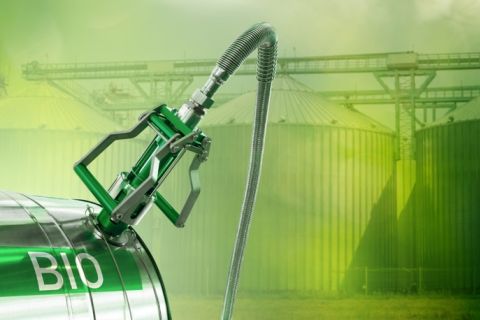Hydrates – ice-like structures that form when water and natural gas combine in high-pressure (HP), low-temperature conditions and block the wellbore – are one of the most common challenges in exploratory deepwater wells. The phenomenon is especially prevalent in presalt environments such as Brazil, where the water depth and temperatures at the seafloor cause gas to generate hydrates during drilling or well-testing operations.
Hydrate formation occurs in environments where changes in wellbore diameter and circulation slow down the velocity of the gas, typically during startup, shutdown, blowdown, or bleeding-off operations. When the slower-moving gas from the formation reaches the point where differential pressure rises and temperature drops, the hydrate forms quickly, trapping pressure below and cutting off access to the lower section of the well. Hydrates can occur in the wellbore, pipeline, subsurface tree, or accessories in the subsea manifold.
Remediating hydrates in deep water
The key objective in remediating hydrates is to resume operations with the least amount of nonproductive time while avoiding risks. Hydrate plugs that form in the riser must be removed without damaging the tubing, downhole valves, and subsea tools across the BOP. Pressure losses through the umbilical must be limited while maintaining safe injection rates of chemicals to wash out the hydrates. It also is important to understand that hydrates can be very hard and strong and hold high differential pressures, potentially making a projectile out of the formerly plugged object.
During a well-testing operation in a deepwater well offshore Brazil, Schlumberger breached a hydrate that had formed in the subsea test tree by using a combination of chemicals pumped through an HP rotating nozzle deployed with coiled tubing (CT). The operation, which took less than four hours, involved a novel application of an established well-cleaning tool that has been used effectively for a variety of intervention needs – the Jet Blaster engineered HP jetting service.
The Jet Blaster technology uses engineered nozzles arranged in a rotating head to deliver HP jetting at a controlled speed, leading to reduced risk of damaging tubular or downhole installations. Its one-trip cleanouts also require fewer chemicals, helping to lower treatment costs. The technology is supported with a jetting hydraulics modeling module within a CT design and includes an evaluation software platform to enhance CT operations and verify job design.
The service is often used to facilitate CT execution, pumping, and chemical treatment for a wide range of applications, including sand cleanouts, tubing-scale removal, screen cleaning, and near-wellbore skin removal. It is engineered for harsh environments and equipped with a drift ring that controls the ROP. The nonmetal cutting or gridding capability protects completion installations from damage.
Successful remediation
The deepwater discovery well in this case was located in Brazil’s Campos Basin in waters 2,801 m (9,190 ft) deep between two presalt accumulations forming a large hydrocarbon column. From a drillship, the operator performed a flow test in a partial section of the pay zone, with promising results obtained during a choked drillstem test (DST) with very limited drawdown.
The well test was carried out with Schlumberger’s SenTREE subsea test tree, which is used for exploration and appraisal well-testing. SenTREE has standardized modules that can be integrated with any subsea BOP stack for increased flexibility; its shut-in and unlatch capability at the seabed helps reduce risk should it be required to move off the well.
During the well test, flowing wellhead pressure, temperature, and flow rate decreased, indicating a possible hydrate plug in the riser between the surface and the subsea wellhead. The well was shut in, and after several attempts to reopen the well, the operator determined that the riser was plugged with a hydrate formation at a depth of 1,593 m (5,226 ft).
Downhole motors and milling tools frequently are used to wash out hydrate plugs and restore wellbore flow. This case, however, warranted a different approach because the motor and milling tools were not available onsite and there was uncertainty regarding whether the hydrate could be located in the DST string, such as the retainer valve, which could be damaged by using a downhole motor and mill.
Based on the challenges and uncertainties the hydrate formation presented, Schlumberger proposed that its JetBlaster system with a 25/75 monoethylene glycol (MEG)/base-oil mud mixture be deployed by a CT unit that had been brought onboard as a contingency measure in the event of hydrate formation.
In planning the remediation operation, the Jet Advisor scale removal software was used to determine the best-performing configuration for the HP rotating nozzle as well as the optimum CT string and fluid treatment. Schlumberger also engaged its CoilCADE wellbore design and evaluation software to simulate all stages of the CT operation and verify that the downhole fluid would allow the deposits to be carried safely out of the well.
The software helped identify forces and stresses expected, displaying force and pressure windows. It anticipated pressures while pumping for safer operations.
Regaining lower well access
Prior to running in the hole, rig personnel and well test engineers performed procedures so that once the CT was downhole, the rig would have continuous recirculation of fluids through the well test choke, surge tank, cementing pump, and CT to the well. The pumping rate while running in the hole was 0.6 bbl/min until the hydrates were identified, at which point the crew began pumping the MEG/base-oil mud mixture continuously through the umbilical to the subsea test tree while the CT was in the hole.
In removing the 83-m (273-ft) hydrate plug, the closed-loop pump rate of the chemicals was increased to between 0.8 bbl/min and 0.9 bbl/min through the HP rotating nozzle. While jetting, about 200 psi backpressure was maintained with the surface choke to limit the amount of differential pressure across the plug. Had no progress been made during the procedure, the backpressure would have been reduced.
When the CT reached 1,798 m (5,899 ft), a pressure spike of 2,500 psi detected at the surface indicated the plug had been removed and access to the lower wellbore had been restored. The wellhead pressure was then bled down to 200 psi before continuing the operation. The CT was run in the hole to the final depth of 4,100 m (13,451 ft), with pull tests taken every 200 m (656 ft) to drift the DST string. Throughout the CT operation, the intelligent remote dual valve, which provides independent commands for the testing valve and the circulation valve in the tool string, remained closed.
After confirming there were no additional hydrates in the well, the CT was pulled out of the hole to allow the well test operation to resume. The remediation was completed with no safety incidents or damage to equipment or the environment. The average ROP of the procedure was 20.9 m/hr (68.5 ft/hr) across the hydrate plug between the depths of 1,715 m and 1,798 m (5,626 ft and 5,899 ft).
The deployment of the HP rotating nozzle with CT gave new purpose to a tried-and-true intervention technology, providing value for the customer in achieving a safe and efficient operation to bring the deepwater well back online and expanding the toolbox for hydrate remediation applications going forward.
Recommended Reading
Bunge, Chevron Announce FID on Oilseed Processing Plant
2024-03-05 - Bunge Chevron Ag Renewables' facility will be used to manufacture low carbon renewable fuels from oilseed.
Trace Carbon Solutions Applies for First Phase of Class VI Wells at Evergreen Hub
2024-03-12 - Trace is applying for its subsidiary Evergreen Sequestration Hub to be allowed to permanently sequester CO2 in underground geological formations in Louisiana.
EnCap Launches Bildmore to Invest in Hard-to-finance Clean Energy
2024-03-11 - In an effort to support hard-to-finance clean energy projects, EnCap Energy Transition Fund is launching Bildmore, a platform expected to invest in up to 15 third-party battery storage, solar and other energy transition projects per year.
Avangrid to Build its Fifth Wind Farm in Illinois
2024-03-12 - Osagrove Flats, the 153 MW wind farm, will bring Avangrid’s renewable energy capacity in Illinois to nearly 800 MW.
1PointFive, AT&T Enter Carbon Removal Pact
2024-03-13 - 1PointFive said it is also participating in AT&T’s Connected Climate Initiative to collaborate on carbon removal solutions like direct air capture.





